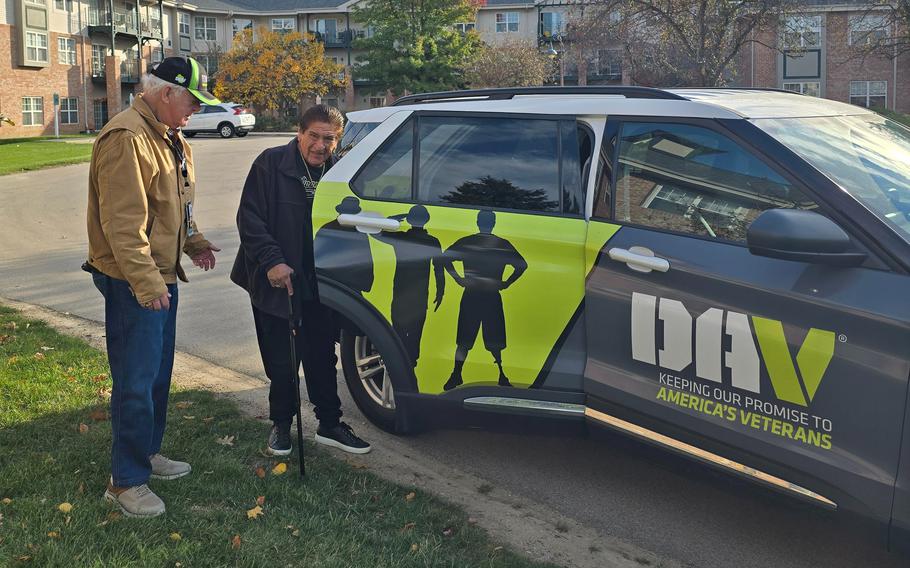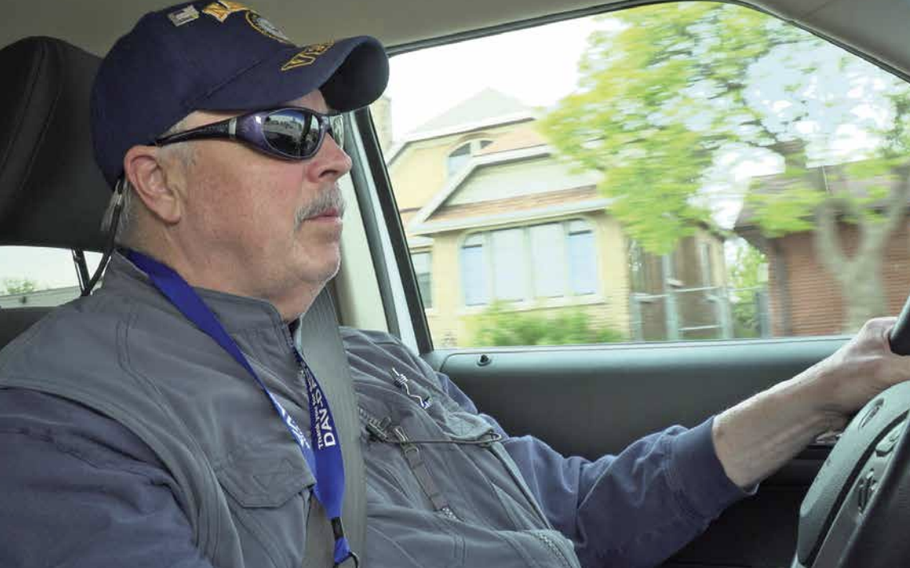
John Polk, an Army veteran and volunteer with the Disabled American Veterans, picks up veteran William Bash of Oak Creek, Wisc., on Wednesday, Oct. 23, 2024, to drive him to his medical appointment at the Milwaukee VA Medical Center. (John Polk)
WASHINGTON — Army veteran John Polk has been a volunteer driver for 10 years with Disabled American Veterans, giving veterans in Wisconsin rides to doctor appointments at the Milwaukee VA Medical Center and other health care facilities run by the Department of Veterans Affairs.
“If the DAV did not pick up these veterans, they would have a hard time getting to the doctor,” he said.
Without help from Polk, 77, and other volunteer drivers, veterans who do not have transportation — a particular problem in rural areas — would be stranded and unable to make their VA appointments.
“We hear a lot from veterans in rural areas who say that ‘no one wants to help us,’” said Patty Davis, a DAV transportation program manager and coordinator for transportation services at the Milwaukee VA. “I just don’t have the drivers to fill all the areas where services need to be.”
Transportation problems account for 1.8 million missed VA medical appointments annually, costing the agency about $4.4 billion a year.
The VA, in response, began rolling out VA-Uber Health Connect nationwide in 2024, leveraging the popular rideshare service to fill transportation gaps for veterans. The rollout follows a two-year pilot program that tested and adapted the rideshare service for veterans’ medical appointments at VA facilities in several states.
Veterans do not use the Uber app to access rides. Instead, they contact a scheduler at the VA after enrolling in the program.
But the collaboration has hit a dead end for many veterans living in rural and hard-to-reach communities where rideshare services are scarce or nonexistent.
Approximately 25% of veterans — numbering more than 4 million — live in rural or highly rural areas, according to the VA.
Polk volunteers once or twice a month to drive into tiny communities in Washington and Waukesha counties in western Wisconsin, where Uber, taxis and public bus service are infrequent or unavailable.
“The addition of the Uber Health program has no impact in these rural communities,” said Polk, a retired major who served in the Army from 1967-1993, with deployments to Vietnam.
Polk and other volunteers sometimes are the only transportation for disabled veterans in rural communities.
There’s an urban-rural divide when it comes to the availability of ride-sharing services, according to the Pew Research Center. Uber drivers are paid based on the number of rides and rely on frequent calls for service. Ride-sharing in rural areas is slowed by low demand and inconsistent access to the internet for users.
“Uber does not have much of a presence in places like Antelope Valley, where some of the biggest transportation challenges exist for our veterans,” said William Regen Wilson, public affairs consultant with the Department of Military and Veterans Affairs for Los Angeles County.
Antelope Valley is an hour’s drive north of Los Angeles, a community at the edge of the Mojave Desert. Wilson said there are significant problems getting people to their VA appointments.
“There is no congressional mandate, and no funds set aside to fix the transportation issues,” he said.
Though the Rural Veterans Transportation to Care Act was introduced in early 2024 to qualify more veterans service organizations in highly rural areas for transportation grants, the legislation has yet to be debated in a congressional committee. The legislation’s goal is to help give rural veterans without vehicles options for getting to their VA appointments.
Jon Retzer, the assistant national legislative director for the Disabled American Veterans, said legislation for veterans that requires new or additional funding has been slow to advance in Congress this year. The DAV has been supplementing VA’s own transportation services since 1989 and has 3,000 trained volunteers nationwide who help with driving veterans to appointments.

Navy veteran Tom Bierbach, 75, a volunteer driver with Disabled American Veterans in Wisconsin, takes a fellow veteran to a medical appointment at a clinic run by the Department of Veterans Affairs. (Disabled American Veterans.)
In 2023, they transported more than 245,000 veterans to their VA appointments.
The organization also donates vans to the VA for its own transportation services. In 2024, the organization gave 75 new vehicles to VA medical facilities at a cost of $3 million.
An estimated 5 million veterans, many of them aging, have transportation challenges in accessing VA medical care, according to Indra Sandal, a physician and chief of innovation at James A. Haley Veterans’ Hospital and Clinics in Tampa, Fla.
Sandal said some VA hospitals participating in the VA-Uber program are prioritizing the agency’s own van service to pick up veterans in remote areas, instead of simply responding to requests on a first-come, first-served basis.
These hospitals then rely on VA-Uber Health Connect to help veterans in urban communities closer to VA medical facilities.
Sandal developed the VA-Uber collaboration for a pilot program that ran from April 2022 to April 2024. The Uber program underwent a test drive to see how well it met demand for getting veterans to scheduled doctor visits.
VA-Uber Health Connect first operated at 10 medical centers in four states — Missouri, Kansas, Tennessee and Kentucky. The main goals for partnering with Uber are to reduce no-shows and missed appointments as well as improve the health care transportation experience, said Terrence Hayes, the VA press secretary.
Veterans have no out-of-pocket costs when using the ride-sharing service and do not need to submit claims for travel reimbursement.
The program has grown to 101 medical facilities in 2024, serving more than 50,000 veterans. Plans are underway to make the rideshare service available at every VA medical center.
From May to October 2024, the Veterans Health Administration provided 274,000 rideshare trips to eligible veterans, according to the VA. Use keeps growing.
The VA also renewed its partnership with Lyft, a ridesharing service it used during the coronavirus pandemic. The VA pays the market rates for rideshare services.
When a veteran reaches out to the local VA transportation office for a ride, the VA assesses the veteran’s eligibility and ensures there is a VA-authorized appointment in place. To access rides, veterans must have a disability rating of 30% or higher and be receiving care for service-connected injuries.
The transportation office schedules and coordinates rides. The office sends the veteran messages on the ride status.
“I live out here in the desert,” said Army veteran Steve Johnson, 66, of Arizona, who has vertigo from a traumatic brain injury that he suffered in military training at Fort Leonard Wood, Mo. “I’ve heard of this new Uber service with the VA. But Uber doesn’t travel out here. There is no way that a bus can even get close to me.”
Johnson, a private who was medically discharged after serving from 1976-1977, lives near Vail, about an hour’s drive from Tucson. He said he usually drives himself to appointments at the Tucson VA Medical Center. He then submits paper claims for travel reimbursement.
But earlier this year, Johnson said he was experiencing dizziness and feeling weak when his legs gave out as he was walking outside his home. He could not get to his vehicle or drive to his VA appointment.
“The VA told me to call an ambulance,” he said.
Johnson was able to reach a friend to drive him to the VA for care. He said it would help if he had transportation assistance, but he does not expect to see on-demand rides anytime soon in this remote desert community.
“This is where I can afford to live on my budget, and I’m not about to move,” Johnson said. “Where I live seems to be a good fit. It’s quiet, has fewer problems and there’s lots of open space.”